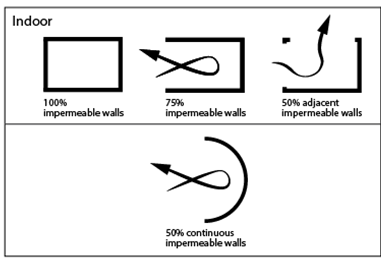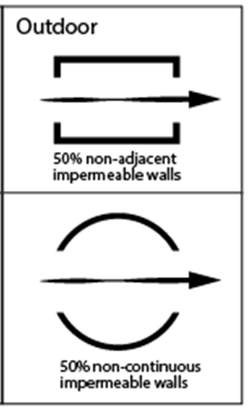1. How does the state determine if a setting is outdoor or indoor?
CDPH has issued guidance to set the standard for determining if a setting is outdoor. These determinations are based on the anticipated level of cross-ventilation that the structure allows for. Settings that provide cross-ventilation with fresh outdoor air, allowing the virus to disperse rapidly and move out of the space, are considered outdoor settings. If a setting does not have adequate ventilation, the air will become trapped inside and the virus will remain in the air and become more concentrated. Those are considered indoor settings.
Outdoor settings have open-air ventilation that allows air movement. Air movement allows droplets and aerosols containing the COVID-19 virus to disperse rapidly to low concentrations and move "out" of the space. When there is less air movement, which can occur in inadequately ventilated indoor environments, virus particles are trapped inside the space. The concentration of the virus increases as people continue to breathe out the virus.
2. What type of outdoor structures disrupt or confine cross-ventilation and are considered “indoor”?
A structure with more than 50% of the sides “closed,” or made up of impermeable walls that air cannot flow through, is considered an indoor setting. A structure with 50% or less of the sides “open,” or made up of permeable wall material, is still considered an indoor setting if the open side is continuous or made up of adjacent walls that form a corner.
These structures (see examples in graphic) would have limited air flow (i.e. inadequate “cross-ventilation”) and the virus particles would remain concentrated, particularly for people farthest away from the “open” side of the structure.

3. What type of outdoor structure does not disrupt or confine cross-ventilation and is considered “outdoor”?
A structure with 50% (or less) non-adjacent “closed” walls, and at least 50% non-adjacent “open” sides, like a tunnel, is considered an outdoor setting. This configuration allows for much higher levels of natural ventilation and cross-ventilation that will dilute the virus and move it out of the space more rapidly.
A structure meeting the “outdoor” definition as described here may have a roof or canopy to protect occupants from sun or rain.

4. What is the difference between a “permeable” and an “impermeable” barrier?
An impermeable wall is defined as any material type that does not allow air to pass through without restriction. Examples include a tarp, plastic barrier, or a fabric curtain.
By contrast, a permeable wall is defined as any material that allows for air to easily pass through and does not significantly impede air flow. Examples include a lattice fence with widely separated slats or a coarse mesh screen.
In addition to the composition of the barrier, air flow can be affected by the height, number, and angle of the barriers, as well as the percentage of the space covered by impermeable barriers. For a barrier to be considered permeable, air must be able to flow across the entire length and width of the barrier without restriction.
5. Can I put umbrellas/canopies up over tables?
Umbrella/canopies with no walls allow for open air ventilation and the rapid dispersal of droplets/aerosols and are considered an “outdoor” structure. All such umbrellas and tents, may not obstruct access to or ventilation of utility covers, and must be ADA compliant.
6. Can I use heaters, fans, swamp coolers, etc.
Yes, however, we strongly recommend that you place fans so that they do not blow air between different groups of patrons. Fans do not increase ventilation in a manner sufficient to permit use of enclosed shelters that would otherwise not be considered outdoor structures.
7. Is increased cross-ventilation a replacement for other precautions such as distancing or masks?
No. By itself, increasing ventilation is not enough to protect people from COVID-19. You should increase ventilation and follow other best practices recommended by CDPH, CDC, and others, including disinfecting frequently touched surfaces, frequent handwashing, wearing masks (when not actively eating or drinking), and physical distancing.
Originally Published on January 5, 2021